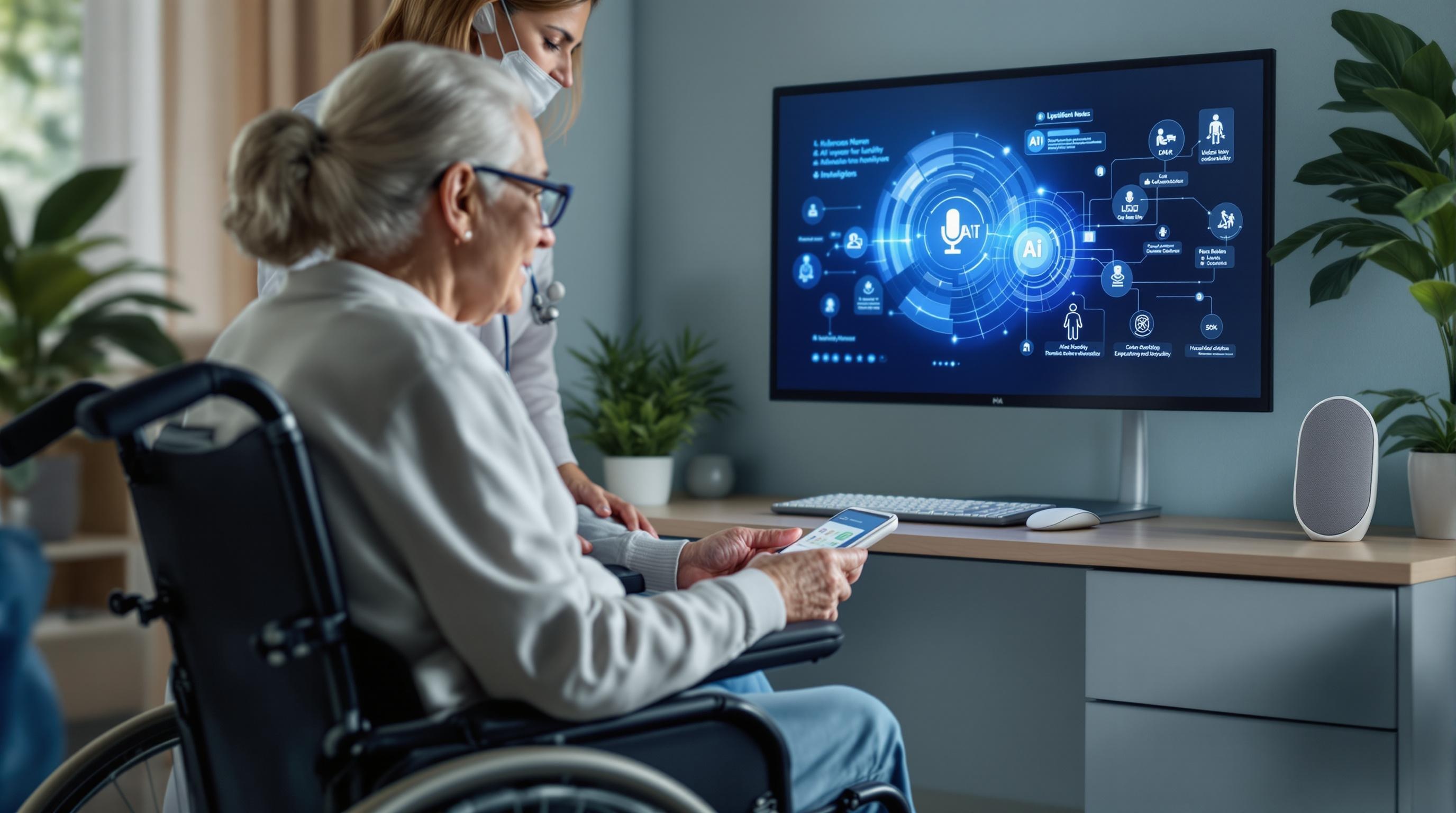Memory Care Facility Technology: Innovations for Skilled Nursing
Explore the latest memory care facility technology transforming skilled nursing, from AI companions to smart tools enhancing resident safety and engagement.
Quick Navigation
- 1. Introduction
- 2. Current Challenges in Memory Care Facility Technology
- 3. How Sparkco AI Transforms Memory Care Facility Technology
- 4. Measurable Benefits and ROI
- 5. Implementation Best Practices
- 6. Real-World Examples
- 7. The Future of Memory Care Facility Technology
- 8. Conclusion & Call to Action
1. Introduction
Imagine a world where technology not only supports, but transforms the way we care for individuals with memory loss in skilled nursing facilities. Today, that vision is rapidly becoming reality. In fact, the adoption of artificial intelligence (AI) and other digital innovations in long-term care has surged, with AI-driven solutions ranking among the top five tech trends impacting aging services in 2024. As the population ages and dementia rates continue to rise, the demand for advanced, compassionate memory care has never been greater.
Yet, providing high-quality memory care remains a significant challenge. Caregivers must balance residents’ safety, emotional well-being, and daily routines—often while navigating staffing shortages and increasing expectations from families. Traditional approaches, though grounded in empathy, can struggle to deliver truly personalized support or actionable insights that improve outcomes for residents with Alzheimer’s or dementia.
This article explores how cutting-edge technology is reshaping memory care in skilled nursing facilities. We’ll examine the latest advancements, from AI companions that foster meaningful engagement, to smart monitoring systems that enhance safety and streamline workflows for staff. Discover how these innovations are not just easing the burden on caregivers, but also enriching the lives of residents—empowering them to experience greater dignity, comfort, and connection. Whether you’re a healthcare professional, caregiver, or family member, join us as we unpack the promise and practicalities of memory care facility technology in today’s skilled nursing landscape.
2. Current Challenges in Memory Care Facility Technology
Memory care facilities are under increasing pressure to adopt advanced technologies that improve the quality of care, streamline operations, and ensure compliance. However, integrating and optimizing technology in these settings presents several significant challenges. Below, we outline the most pressing pain points, supported by data and real-world implications for operations, compliance, and resident care.
-
High Implementation and Maintenance Costs
Upfront investment in memory care technology—such as electronic health records (EHR), monitoring systems, and medication management platforms—can be prohibitive. According to a McKinsey report, healthcare providers spend an average of 3.5% of annual operating budgets on IT, and for smaller facilities, these costs can be even more burdensome. Ongoing maintenance, software updates, and staff training further add to the financial strain. -
Interoperability Issues
Many memory care facilities utilize a patchwork of legacy and new systems that lack seamless integration. According to the Office of the National Coordinator for Health Information Technology, only about 46% of healthcare facilities report that they can electronically exchange patient information with outside providers. This fragmentation creates data silos, hinders care coordination, and increases the risk of errors. -
Staff Training and Adoption
New technologies are only as effective as the staff using them. A 2019 NIH study found that only 60% of long-term care staff felt confident using new digital tools. High staff turnover in memory care settings exacerbates the problem, making it difficult to maintain a workforce that is consistently trained and comfortable with evolving systems. -
Cybersecurity and Data Privacy Concerns
Protecting sensitive resident information is paramount. In 2023, healthcare data breaches affected over 133 million individuals in the U.S. alone (HIPAA Journal). Memory care facilities, which handle large volumes of personal and health data, are increasingly targeted, with compliance to HIPAA and other regulations becoming more complex and resource-intensive. -
User-Friendly Design for Residents with Cognitive Impairment
Memory care residents often struggle with technology interfaces. Systems designed without user-centered considerations can frustrate residents and impede engagement. Technologies must be intuitive and adaptable for those with dementia or Alzheimer’s—a design challenge that many solutions have yet to adequately address. -
Limited Customization and Scalability
Many technology platforms are not specifically tailored for memory care settings, limiting their effectiveness. As facilities grow or resident needs change, these systems often lack the flexibility to scale or customize, resulting in operational inefficiencies and suboptimal patient outcomes. -
Regulatory Compliance Complexity
Memory care facilities must navigate a complex landscape of federal, state, and local regulations. The Centers for Medicare & Medicaid Services (CMS) frequently updates compliance requirements. Keeping technology systems aligned with these evolving standards is resource-intensive and can expose facilities to penalties if not properly managed.
These challenges directly impact operational efficiency, regulatory compliance, and, most importantly, the quality of patient care. Facilities that cannot overcome these hurdles risk increased costs, staff burnout, regulatory penalties, and compromised resident safety. Proactive investment in user-centered, integrated, and secure technology solutions is essential for the future of memory care.
3. How Sparkco AI Transforms Memory Care Facility Technology
Memory care facilities face unique hurdles: residents require close monitoring, rapid response to emergencies, consistent communication among staff, and personalized care. Outdated systems often lead to delayed responses, miscommunication, and increased caregiver burden. Sparkco AI directly addresses these challenges with a cutting-edge, AI-powered technology platform designed specifically for memory care environments.
-
Real-Time Emergency & Wellness Alerts
Sparkco AI’s nurse call system delivers instant alerts to caregivers’ mobile devices. Whether on or off the floor, staff are notified immediately of resident needs or emergencies. AI algorithms prioritize alerts based on urgency and resident history, ensuring swift and appropriate response—crucial for dementia or Alzheimer’s residents who may be unable to articulate their needs. -
Automated Acknowledgment & Accountability
The “I Got It” feature, powered by AI-driven workflow automation, allows caregivers to claim and acknowledge calls in real time. This eliminates duplicate responses, ensures accountability, and streamlines task delegation. Automated time-stamping and tracking also provide oversight for administrators, reducing human error and missed interventions. -
Advanced Resident Locating & Monitoring
Sparkco AI uses smart sensors and location-tracking tools to monitor resident movement throughout the facility. AI analyzes patterns, detects anomalies like wandering (a common memory care risk), and triggers instant alerts to staff. This proactive approach helps prevent incidents before they escalate, keeping residents safe and reducing staff stress. -
Integrated Communication Tools
Seamless, secure messaging enables staff to coordinate care, update each other on resident status, and request assistance—all within one platform. AI-powered communication logs help track key interactions and identify bottlenecks, making handoffs smoother and reducing information loss during shift changes. -
Data-Driven Care Insights
Sparkco AI automatically logs all care activities at the point of service. Customizable dashboards provide actionable insights into response times, resident trends, and caregiver performance. AI analytics highlight areas for improvement, supporting continuous quality enhancement and regulatory compliance. -
Flexible Integration Capabilities
Sparkco AI is designed for seamless integration with existing electronic health records (EHR), medication management systems, and other facility software. Its open API and modular architecture ensure smooth onboarding without disrupting daily workflows, allowing facilities to upgrade technology at their own pace.
By combining AI intelligence, workflow automation, and robust communication features, Sparkco AI empowers memory care facilities to deliver safer, more responsive, and personalized care. Its easy-to-use platform bridges the technology gap, giving staff the tools they need while integrating effortlessly with existing systems.
4. Measurable Benefits and ROI
Memory care facilities face unique challenges, including managing resident safety, ensuring regulatory compliance, and delivering high-quality, personalized care. The adoption of automated technologies—such as telebehavioral health platforms, electronic health records (EHRs), real-time location systems (RTLS), and automated medication management—has transformed how memory care is delivered, resulting in significant returns on investment (ROI) and measurable benefits across operations.
- Reduced Hospitalizations and ED Visits: A three-year study involving over 7,000 long-term care patients found that telebehavioral health programs can lower hospital admissions and emergency department visits by up to 30%. This reduction translates directly to cost savings and improved resident well-being.
- Lower Overall Care Costs: By integrating remote monitoring and telemedicine, facilities report up to a 12% decrease in total care costs per resident per year. Automated alerts and early interventions help avoid costly acute events.
- Time Savings for Staff: Automated EHRs, medication dispensing, and RTLS save nurses and aides an average of 2 hours per shift on documentation, medication rounds, and resident tracking. This time can be redirected to direct care, enhancing resident engagement.
- Improved Medication Compliance: Automated medication management systems have been shown to reduce medication errors by up to 75%, improving compliance and reducing adverse drug events.
- Enhanced Regulatory Compliance: Digital documentation and automated audit trails help facilities maintain compliance with CMS and state regulations, with some providers reporting a 40% reduction in compliance-related deficiencies during inspections.
- Staff Retention and Satisfaction: By automating routine tasks, staff report higher job satisfaction. Facilities implementing technology-driven workflows see a 20% decrease in annual staff turnover, according to industry case studies.
- Family and Resident Satisfaction: Automated communication platforms and real-time updates improve transparency, with resident family satisfaction scores increasing by 15-20% following implementation.
- Data-Driven Quality Improvements: Facilities using advanced analytics from automated systems can identify care gaps and trends, leading to ongoing quality improvement and up to 10% better clinical outcomes for residents with dementia or behavioral health needs.
The measurable benefits of automation in memory care are clear—not only in bottom-line ROI but also in resident safety, staff efficiency, and compliance. For more details on the positive financial and clinical impact of telebehavioral health and related technologies, see the HFMA case study.
5. Implementation Best Practices
Integrating technology in memory care facilities requires a structured approach to ensure regulatory compliance, staff adoption, and positive resident outcomes. Below are actionable best practices for successful implementation, complete with practical tips, common pitfalls to avoid, and change management considerations.
-
Conduct a Comprehensive Needs Assessment
Engage staff, residents, and families to identify current challenges and prioritize technology needs, such as wander management, electronic health records (EHR), or engagement platforms.
Tip: Use surveys and focus groups for inclusive input.
Common Pitfall: Overlooking frontline staff insights, leading to misaligned solutions. -
Align with Regulatory Requirements
Ensure any new technology meets CMS guidelines and state regulations, including privacy and safety standards.
Tip: Review the latest CMS surveyor guidance and consult compliance officers early.
Common Pitfall: Implementing systems without thorough compliance checks, risking citations. -
Involve Multidisciplinary Stakeholders
Form an implementation team with representatives from nursing, IT, administration, and family councils.
Tip: Assign clear roles and responsibilities for each team member.
Common Pitfall: Leaving out key voices, which can impede buy-in and effectiveness. -
Develop a Detailed Implementation Plan
Create a step-by-step rollout schedule, including pilot testing, staff training, and resident/family orientation.
Tip: Start with a small-scale pilot to identify and address issues before full deployment.
Common Pitfall: Skipping pilots, resulting in widespread disruptions or user resistance. -
Prioritize Staff Training and Support
Offer hands-on, role-specific training sessions and ongoing support resources.
Tip: Use real-life scenarios and refresher sessions to boost confidence.
Common Pitfall: Treating training as a one-time event, which can lead to skill gaps and underutilization. -
Engage Residents and Families
Communicate the benefits of new technologies and involve residents and families early in the process.
Tip: Host demonstration sessions and Q&A forums to address concerns.
Common Pitfall: Neglecting to inform residents/families, increasing anxiety or mistrust. -
Monitor, Evaluate, and Iterate
Establish metrics for success (e.g., reduction in incidents, improved engagement) and gather feedback for continuous improvement.
Tip: Schedule regular check-ins and adjust workflows as needed.
Common Pitfall: Failing to track outcomes, missing opportunities for optimization. -
Plan for Change Management
Prepare staff and residents for change by addressing fears and fostering a culture of innovation.
Tip: Identify change champions within your team to promote positive attitudes.
Common Pitfall: Underestimating resistance to change, which can undermine project success.
By following these best practices, memory care facilities can implement technology effectively—improving resident safety, care quality, and staff satisfaction while staying compliant with evolving regulatory standards.
6. Real-World Examples
Real-World Examples: Memory Care Facility Technology in Skilled Nursing Facilities
Adopting advanced technology in memory care units is transforming outcomes for residents and staff alike. The following anonymized case study illustrates how one skilled nursing facility leveraged innovative solutions to enhance care quality, safety, and operational efficiency.
-
Situation:
A 120-bed skilled nursing facility in the Midwest struggled with high rates of resident elopement and frequent nighttime falls among its memory care population. Staff faced challenges in monitoring residents effectively without infringing on their independence, and families expressed concerns about safety. -
Solution:
The facility implemented an integrated memory care technology suite, including:- Wearable real-time location tracking devices
- Fall detection sensors in resident rooms and communal areas
- Electronic health records (EHR) integration for behavioral tracking
- Family communication portals










